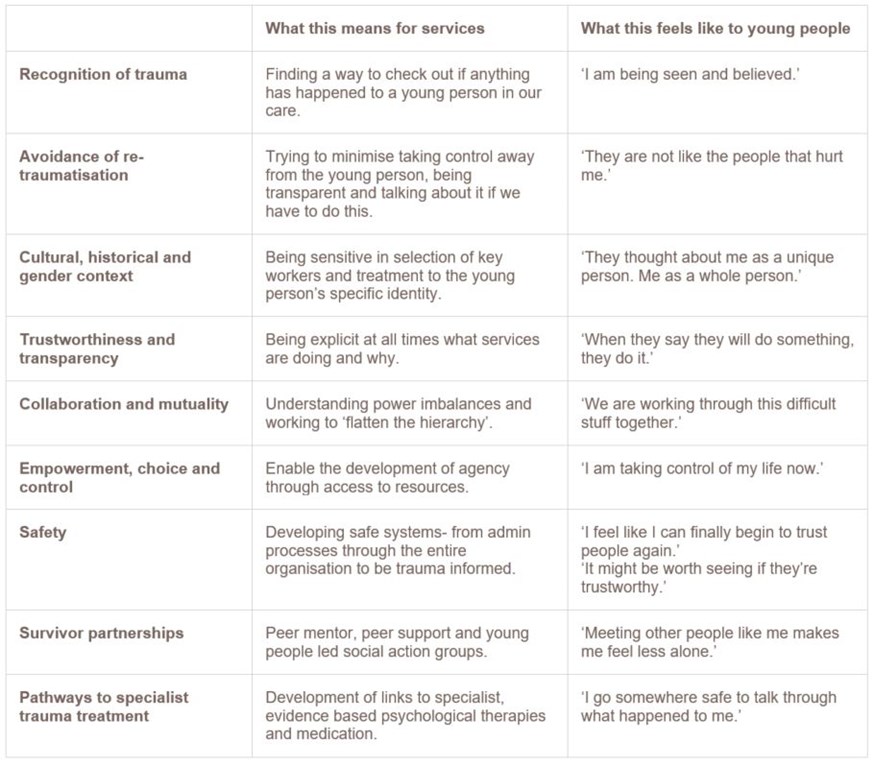I once worked with a young mum who had been referred to a mother and baby assessment unit. The unit was nicely decorated to make it family friendly and homely. As we sat together talking about her baby, I remembered that this mum had been in care.
I asked her what it was like to be back in the system, this time as a mother. She told me about how she had been sexually and physically abused by a member of care staff and that she had managed this by being a ‘bad little girl’ who was always naughty and loud. We talked about how clever a strategy this was to protect herself as a child, but how this way of managing might not serve her as well now.
After we had spoken I couldn’t help noticing the things about the assessment unit that gave it away as not being a proper home. The fire extinguisher on the wall, the heavy doors, the staff office at the front of the building with a latch on the door. It occurred to me that this might have been very like the building that this mum had been housed in as a child. A place that looked like a home, but wasn’t. I wondered if she might be subtly triggered by these physical reminders of her childhood abuse and if she was in a state of reliving her trauma while trying to look after her baby. Surrounded by people who seemed to mean well, but also reminded her of her abuser. Sadly, the assessment unit stay did not go well. However, I think that this mum and I were able to think together about the impact her traumatic past was having on her life now. Also how important it was to separate out the past from the present in order for her to have a different future with her baby.
This story can help us to be in touch with what it is like to live with trauma. Sensing that no matter where we turn, there are reminders all around us of terrible things that may have happened. That often the strongest reminders of trauma are not outside at all, but inside our minds and bodies, like unwanted guests who refuse to leave us in peace (Fraiberg et al, 1975). It speaks to the fact that for many traumatised young people, the behaviors they display, which we consider challenging, are actually ways they have learnt to try and protect themselves (Ford and Blaustein, 2013). This young mother’s story also helps us to understand how difficult it is for survivors of trauma to trust that help offered by authority figures, such as professionals, is genuine and that the intimacy offered by a therapeutic relationship is different from the forced intimacy and abuse that characterise physically and sexually abusive relationships. It helps us remember the uncomfortable truth – that many of the young people in our social care, mental health and justice systems are victims of abuse and neglect (Young Minds, 2018) and that sometimes rather than helping them, service provision can inadvertently lead to retraumatisation (Ho et al, 2008).
Trauma-informed approaches
One way to work with traumatised young people is to build upon social work’s commitment to relationship-based practice and develop services that adhere to the principles of trauma-informed approaches. The core components of this approach, and some suggestions for how they might be enacted by practitioners and then experienced by young people, are detailed below (Sweeney et al, 2016):

Conclusion
For professionals working in a trauma-informed way – listening to young people carefully, helping them recognise how past experiences influence their ways of relating to the world today and offering a trustworthy relationship where they can try to build a safer life for themselves – might be the most important service we can offer them (Knight, 2015). It is through this re-forging of social bonds and the development of different types of relationships that young people can learn to live with the legacy that trauma leaves and where the hope for a different type of life can be fostered.
Related resources
Resources relating to trauma research and trauma informed approaches
How trauma research is being used in the UK
A social work piece on re-traumatisation
References
Ford J and Blaustein M (2013) ‘Systemic Self-Regulation: A Framework for Trauma-Informed Services in Residential Juvenile Justice Programs’. Journal of Family Violence 28 (7) 665–677.
Fraiberg, Selma, Adelson, Edna and Shapiro, Vivian (1975) Ghosts in the Nursery: A Psychoanalytic Approach to the Problems of Impaired Infant-Mother Relationships. Available online: http://infantmassage.org.au/wp-content/uploads/2014/11/Fraiberg-Ghosts-in-Nursery.pdf
Ho et al (2008) Creating Trauma-Informed Systems: Child Welfare, Education, First Responders, Health Care, Juvenile Justice. Available online: https://pdfs.semanticscholar.org/642b/2b0ae392ccd12d2c8c1c006a80238a98d099.pdf
Knight (2015) Trauma-Informed Social Work Practice: Practice Considerations and Challenges. Available online: https://www.researchgate.net/publication/271773782_Trauma-Informed_Social_Work_Practice_Practice_Considerations_and_Challenges
Sweeney et al (2016) Trauma-informed mental healthcare in the UK: what is it and how can we further its development? Available online: https://www.emeraldinsight.com/doi/full/10.1108/MHRJ-01-2015-0006
Young Minds (2018) Addressing Adversity – Prioritising adversity and trauma-informed care for children and young people in England. Available online: https://youngminds.org.uk/media/2142/ym-addressing-adversity-book-web.pdf




